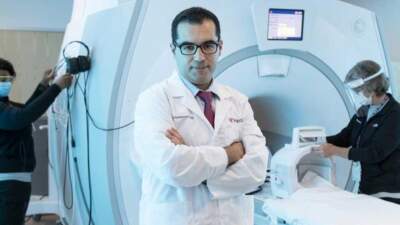Since the pandemic hit, researchers have been uncovering ways COVID-19 impacts other parts of the body, besides the lungs.
CT Scan
An image produced by a CAT scanner. Also called CT scan. Computed tomography (also known as CT, CT scan, CAT, or computerized axial tomography) scans use x rays to produce precise cross-sectional images of anatomical structures of the body
3D printed device saved life of a baby with tracheobronchomalacia
Baby’s life saved with groundbreaking 3D printed device from University of Michigan that restored his breathing — Bioresorbable splint used for first time, successfully stopped life-threatening tracheobronchomalacia, case featured in New England Journal of Medicine – Every day, their baby stopped breathing, his collapsed bronchus blocking the crucial flow of air to his lungs. April and Bryan Gionfriddo watched helplessly, just praying that somehow the dire predictions weren’t true.
Blocked heart arteries can cause stroke
Clogged heart arteries can foreshadow stroke — American Heart Association Rapid Access Journal Report – Blockages in your heart arteries could mean you’re more likely to have a stroke, even if you’re considered low risk. A new study raises the need for intensified interdisciplinary efforts for providing adequate disease prevention and management strategies for stroke.
Delivery of drug tPA directly into brain helps stroke patients
Treatment with clot-busting drug yields better results after stroke than supportive therapy alone – In an update to previous research, Johns Hopkins neurologists say minimally invasive delivery of the drug tPA directly into potentially lethal blood clots in the brain helped more patients function independently a year after suffering an intracerebral hemorrhage (ICH), a deadly and debilitating form of stroke.
New CT scanner provides better images with minimal radiation
Next-generation CT scanner provides better images with minimal radiation – A new computed tomography (CT) scanner substantially reduces potentially harmful radiation while still improving overall image quality. National Institutes of Health researchers, along with engineers at Toshiba Medical Systems, worked on the scanner.
Breast cancer risk can be reduced by avoiding unnecessary CT scan
Breast cancer risk can be lowered by avoiding unnecessary medical imaging — UCSF analysis of IOM report on environmental causes of breast cancer suggests there is at least 1 way women can reduce risk – A report issued by the Institute of Medicine (IOM) last December reviewed all the available scientific data compiled to date about potential environmental risks of breast cancer?factors such as pesticides, beauty products, household chemicals, and the plastics used to make water bottles.
A better imaging agent for heart disease and breast cancer
A better imaging agent for heart disease and breast cancer – Scientists are reporting development of a process for producing large quantities of a much-needed new imaging agent for computed tomography (CT) scans in heart disease, breast cancer and other diseases, and the first evidence that the material is safe for clinical use.
CT scans radiation raise cancer risk
Studies quantify radiation doses, cancer risks from CT scans — Variable doses of radiation raise safety concerns for CT procedures. – Radiation doses from common CT procedures vary widely and are higher than generally thought, raising concerns about increased risk for cancer, according to a new study led by UCSF imaging specialists.
Atherosclerosis, heart disease found in Egyptian mummies
Heart disease found in Egyptian mummies — Findings suggest that atherosclerosis is not only a modern disease. – Atherosclerosis or hardening of the arteries has been detected in Egyptian mummies, some as old as 3,500 years, suggesting that the factors causing heart attack and stroke are not only modern ones; they afflicted ancient people, too.
Learn to deal with inattentive, hyperactive & impulsive kids
ATTENTION PARENTS AND TEACHERS! LEARN TO DEAL WITH INATTENTIVE, HYPERACTIVE & IMPULSIVE KIDS – ADHD is a disorder of the brain and behavior. It affects about 3 to 5% of children. The symptoms start before seven years of age. Global prevalence for children is approximately 5%, with wide variability dependent on research methodologies utilized in studies.

